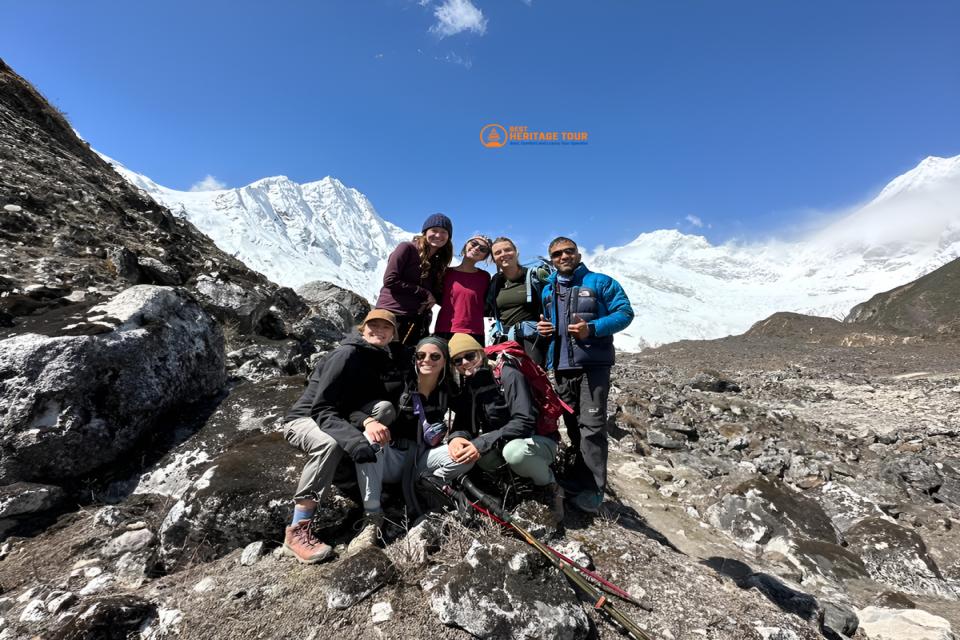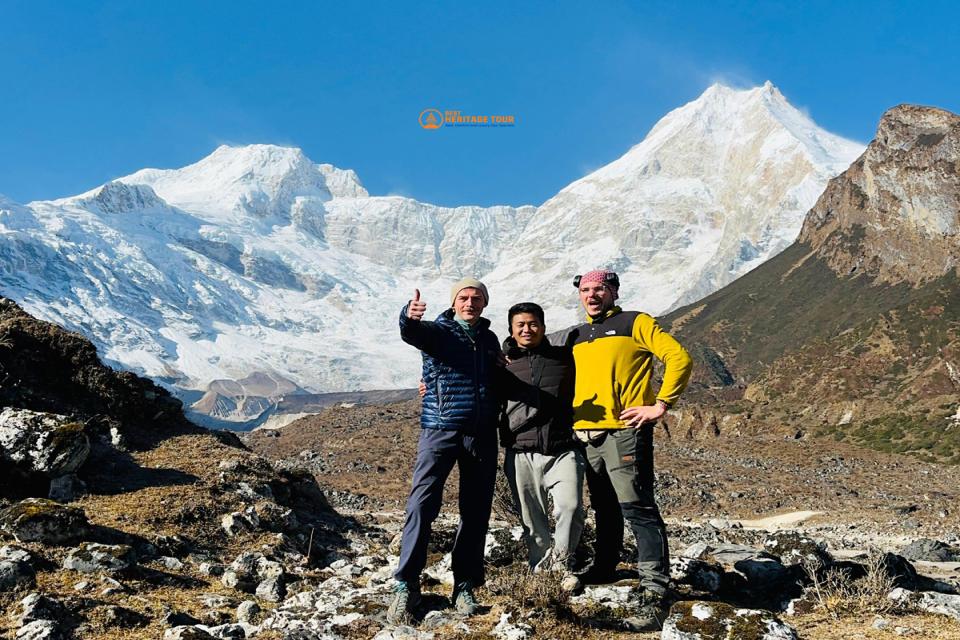The Manaslu Circuit is often regarded as one of Nepal’s most rewarding trekking experiences. While trekkers are drawn by the awe-inspiring views of the eighth-highest peak in the world, the region is equally renowned for its rich cultural and spiritual heritage. Ancient monasteries perched on hillsides, intricately carved Mani walls, and traditional Tibetan Buddhist villages create a unique tapestry of devotion, artistry, and Himalayan life.
Every step along this circuit is an opportunity to witness centuries-old traditions, observe rituals, and connect with local communities who have preserved their spiritual and cultural identity against the backdrop of the mighty Himalayas. Trekking with Best Heritage Tour ensures not only a safe and comfortable journey but also a deep immersion into this living cultural landscape.
Trekking Through Sacred Landscapes
Unlike many other trekking routes, the Manaslu Circuit offers a journey through a region that remains relatively untouched by mass tourism. As trekkers progress through lush forests, terraced fields, and high-altitude passes, they encounter villages with centuries-old monasteries and Mani walls that line the trails. These sites are more than religious symbols - they are vibrant centers of community life and spiritual practice.
The trek allows visitors to see Himalayan culture in its natural setting, where spirituality, agriculture, and local traditions are intertwined. Villagers rely on these religious structures not only for worship but also as social hubs where festivals, ceremonies, and communal gatherings take place.
Monasteries of the Manaslu Circuit - Guardians of Spiritual Heritage
The Manaslu region is home to numerous monasteries, each with a unique history and spiritual significance. These monasteries are architectural marvels, spiritual centers, and cultural repositories, offering trekkers an authentic glimpse into Tibetan Buddhist life.
1. Samagaun Monastery
Samagaun, nestled against the majestic backdrop of Manaslu, houses one of the oldest monasteries on the circuit. Its whitewashed walls, colorful prayer flags, and intricately painted interiors make it a serene retreat for meditation and reflection. Visitors can witness monks chanting, performing daily rituals, and offering blessings to pilgrims and trekkers.
Unique Features:
-
Murals depicting Buddhist teachings and local legends.
-
Strategic location with panoramic views of Manaslu and nearby peaks.
-
A tranquil environment that blends spiritual practice with natural beauty.
2. Deng Monastery
Deng Monastery is located in a quaint village and reflects a blend of Tibetan and Lhomi architectural styles. Inside, intricately painted walls tell stories of deities and spiritual journeys, while prayer flags sway in the Himalayan breeze. Festivals and community prayers are common, offering trekkers a glimpse of local devotional life.
Unique Features:
-
Traditional Lhomi architecture with vibrant murals.
-
Hosting local festivals and community events.
-
Peaceful courtyard ideal for meditation and photography.
3. Lho Monastery
Perched above the village of Lho, this monastery is an active spiritual center. Monks here maintain centuries-old rituals, offering prayers, blessings, and teachings to local villagers and visitors alike. The monastery’s location provides trekkers with sweeping views of surrounding peaks, creating a perfect blend of spirituality and natural grandeur.
Unique Features:
-
High-altitude monastery with panoramic Himalayan views.
-
Educational role in teaching Buddhist philosophy to young novices.
-
Colorful thangka paintings and prayer halls.
4. Shyala Monastery
Shyala Monastery is a smaller yet significant spiritual site along the Manaslu Circuit. It is known for its serene ambiance and the dedication of the monks who maintain its rituals. Trekkers can observe traditional Buddhist practices, light butter lamps, and spin prayer wheels, fully immersing themselves in the local culture.
Unique Features:
-
Quiet and less-frequented, offering solitude for reflection.
-
Traditional wooden architecture blending with the mountainous terrain.
-
Close interactions with resident monks and locals.
5. Sama Monastery
Sama Village, located near the base of the Manaslu peak, hosts a monastery that acts as both a spiritual and cultural hub. The monastery preserves ancient manuscripts and religious artifacts, while monks conduct daily prayers and ceremonies. Visitors can participate in rituals, learning about Tibetan Buddhist practices firsthand.
Unique Features:
-
Repository of ancient religious texts and artifacts.
-
Central gathering place for community celebrations and rituals.
-
Ideal trekking stop to combine spirituality with Himalayan exploration.
Mani Walls - Stone Pathways of Devotion
A distinctive feature of the Manaslu Circuit is the presence of Mani walls - rows of stones engraved with sacred Buddhist mantras, especially “Om Mani Padme Hum.” These walls are spiritual markers that offer travelers a chance to engage with centuries-old devotional practices.
Cultural Significance:
-
Spiritual Protection: Mani walls are believed to safeguard villages and travelers from negative energies.
-
Ritual Practices: Locals often circumambulate these walls, spinning prayer wheels or reciting mantras.
-
Integration with Nature: Positioned along rivers, ridges, and trails, Mani walls harmonize spiritual practice with the surrounding landscape.
Unique Features of Mani Walls:
-
Hand-carved inscriptions reflecting centuries of devotion.
-
Located near monasteries, villages, and high mountain passes.
-
Offer trekkers moments of reflection and cultural learning along the trail.
Trekking Through Cultural Milestones
Walking the Manaslu Circuit is akin to moving through an open-air cultural museum. The trail passes through villages where centuries-old traditions are alive:
-
Villages with Community Monasteries: Trekkers witness daily life intertwined with spiritual practice.
-
Prayer Wheels and Chortens: Small shrines and prayer wheels provide continuous spiritual touchpoints along the path.
-
Festivals and Local Gatherings: Timing your trek with local festivals like Lhosar can immerse travelers in traditional celebrations, music, and dances.
Every monastery, Mani wall, and village along the route offers insight into the region’s history, beliefs, and cultural continuity.
Architectural and Artistic Highlights
The monasteries and Mani walls of the Manaslu Circuit reflect the artistry and architectural genius of Himalayan communities:
-
Intricate Murals: Vibrant depictions of deities, legends, and spiritual teachings adorn the monastery walls.
-
Wood Carvings: Windows, doors, and prayer halls feature delicate wooden carvings crafted by local artisans.
-
Stupas and Courtyards: Many monasteries include stupas, meditation courtyards, and open prayer areas overlooking valleys and peaks.
These architectural features not only enhance the spiritual ambiance but also serve as educational tools for visitors interested in Himalayan art and design.
Spiritual Practices Along the Trail
The Manaslu Circuit offers trekkers multiple opportunities to engage with local spiritual practices:
-
Butter Lamp Ceremonies: Lighting butter lamps is believed to dispel darkness and bring peace.
-
Prayer Wheel Rotations: Spinning the wheels while reciting mantras spreads blessings and positive energy.
-
Meditation and Reflection: Many monasteries provide quiet spaces for personal meditation amidst panoramic Himalayan views.
Participation in these practices, even as a respectful observer, allows trekkers to deepen their connection with the culture and spirituality of the region.
Conclusion - A Trek of Spiritual and Cultural Discovery
The Manaslu Circuit is more than a trekking adventure; it is a journey through the spiritual and cultural heart of the Himalayas. Ancient monasteries, intricately carved Mani walls, and vibrant village life allow trekkers to experience centuries of devotion and tradition.
Trekking with Best Heritage Tour ensures an immersive experience that balances adventure with cultural education, spirituality, and safety. Every step along this route brings travelers closer to the Himalayan way of life, offering insights, reflection, and unforgettable encounters.
Phone/WhatsApp/Viber: +977-9851149197
Email: info@bestheritagetour.com / bestheritetour@gmail.com
Website: www.bestheritagetour.com
Office: Thamel Marg, Kathmandu, Nepal
Author: Best Heritage Tour
Date: 17th August, 2025



